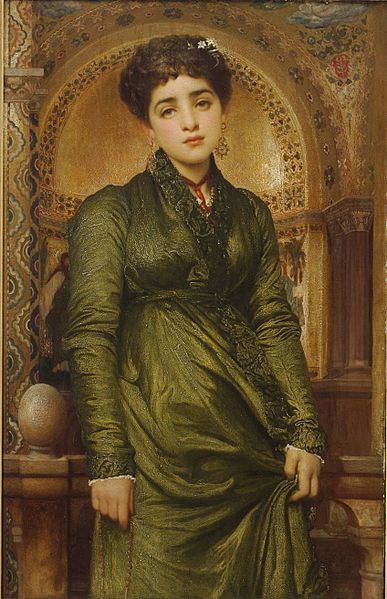Image: Lord Leighton, Frederic, After Vespers, 1871

Description: Catalogue Entry: A member of the Royal Academy by 1864 and elected its president in 1878, Frederic, Lord Leighton reached the apex of the British art world at a young age. Knighted in 1878, ennobled in 1886, and elevated to a life peerage as Baron of Stretton (ironically, the day before he died), he rose through the ranks of society in a manner that was unprecedented for a modern British artist. Leighton’s great success coincided with the Aesthetic movement of the 1870s and 1880s, in which a cult of beauty reigned in literature, the fine arts, and especially the decorative arts. Models were sought from multiple sources, primarily Greco-Roman antiquity, the Middle Ages, the Italian Renaissance, and Asian art, particularly Japanese. Leighton was well prepared to emulate the great Italian masters of the past by his friendships with the Italophiles Robert Browning and John Ruskin, and by his frequent travels abroad. The enigmatic painting After Vespers was exhibited at the Royal Academy in 1872 and again in the posthumous Leighton exhibition of 1897. It brings us into the presence of a lovely young woman who gazes out languidly with an expression of deep melancholy. Framed in the background by a niche in the wall of a church, decorated with ornamental mosaics on a gold background, she seems to be leaving a chapel enclosed by a balustrade with an egg-shaped ornament on the newel post. The mosaics appear to be free adaptations of those in St. Mark’s in Venice. The young lady’s right hand holds a coral rosary, while her left hand lifts her skirt off the dusty floor. In her hair are white flowers, probably a species of rockroses, given the small roots that are visible. According to the symbolic code of flowers that was embraced and elaborated by the Victorians, a certain species of this genus signified imminent death, which may contain a clue to the meaning of the lady’s mournful gaze, or perhaps she simply suffers from the pain of unrequited love. Our speculations can find no satisfactory proof. In the Aesthetic movement in England, the female portrait was often static and mysterious with respect to its exact meaning; in this painting, Leighton draws on that new type of female image, which was introduced by Dante Gabriel Rossetti in the 1860s. The execution of After Vespers displays Leighton at his best as a painter: it has been noted that he varies his brushstrokes to an extraordinary degree, with the spectrum ranging from the soft-focus flesh to the precisely delineated mosaics in the background and a lush impasto in the dress implying a dense, velvety pile in the green fabric. The sensual pleasure of Leighton’s brushwork, coupled with the lack of a true narrative in a painting such as this, has made some critics reassess him as a precociously modern artist. Gallery Label: After Vespers epitomizes the delicacy and refinement that Leighton’s Victorian clients appreciated. The setting, with faithfully reproduced mosaics, is St. Mark’s Basilica in Venice. The painting’s subject, however, is less the magnificent sanctuary than an enigmatic young woman. Her gold earrings and beads mark her elevated social status, and she gently lifts her skirt to keep it off the dusty floor. Her melancholy expression hints, perhaps, at unrequited love.
Title: After Vespers
Credit: Princeton University Art Museum
Author: Frederic Leighton, 1st Baron Leighton
Permission: This is a faithful photographic reproduction of a two-dimensional, public domain work of art. The work of art itself is in the public domain for the following reason: Public domainPublic domainfalsefalse This work is in the public domain in its country of origin and other countries and areas where the copyright term is the author's life plus 100 years or fewer. You must also include a United States public domain tag to indicate why this work is in the public domain in the United States. This file has been identified as being free of known restrictions under copyright law, including all related and neighboring rights. https://creativecommons.org/publicdomain/mark/1.0/PDMCreative Commons Public Domain Mark 1.0falsefalse The official position taken by the Wikimedia Foundation is that "faithful reproductions of two-dimensional public domain works of art are public domain". This photographic reproduction is therefore also considered to be in the public domain in the United States. In other jurisdictions, re-use of this content may be restricted; see Reuse of PD-Art photographs for details.
Usage Terms: Public domain
License: Public domain
Attribution Required?: No
Image usage
The following page links to this image:

